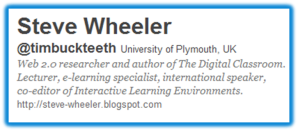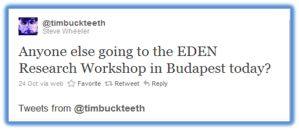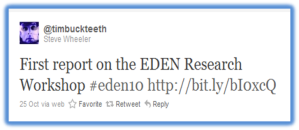This week, to develop the topic of building community, POT Cert continued to read Ko and Rossen, Chapter 6: Building an Online Classroom, and went on to consider the actuality of using technology to build such community. Considered technologies included not only the LMS, but a range of synchronous and audio technologies. Further reading was also indicated with Envisioning the post-LMS Era: The Open Learning Network (Mott, 2010), and it’s Mott’s article, together with the technology of Twitter, that I wish to expand upon in this post.
Twitter can be used to form connections and to create community, and as I mentioned in my post last week, it can be used as a tool for professional development and as a tool for teaching and learning. In contrast to the concept of learning within a “walled” LMS, Twitter fits well with the notion of open learning and with the idea of learning as actualised through a personal learning environment [PLE]. Moves away from the LMS are being mooted because patterns of usage suggest they’re primarily being used for the purpose of administrative efficiency rather than as a platform for substantive teaching and learning activities. A PLE, as opposed to the “vertically integrated and institutionally centralized” LMS, combines small pieces of the open web to create connections for learning “free of the arbitrary constraints of matter, distance, and time” (Weinberger, 2002). Twitter can be one such piece within a PLE, or indeed be adjunct to a LMS based course.
Within this conception, Twitter can be used equally to facilitate and/or support learning: provisioning student-faculty connection, helping create a sense of community, assisting the discovery of relevant and up to date content, enhancing student engagement and connecting students and faculty alike with professional communities of practice (Dunlap and Lowenthal, 2009 and Ebner et al., 2010).
Admittedly, to anyone who’s never tried it Twitter appears frivolous and a distraction from “real work”, never mind to have any serious pedagogical properties. This is so wrong!
Let me show you how I began to realise the power of Twitter.


Why’s he off to Budapest?


Hyper-link to first report on the EDEN workshop.
European Distance and eLearning Network.
Here we can see that a 140 character “tweet” not only allows something very specific to be communicated but, with the insertion of a shortened hyper-link, permits the dissemination of detailed information. What’s more, it also acts as a mechanism through which individuals can create a “peephole” for others to gain an insight into everyday events and discover what’s inviting attention. So, self-disclosure of this nature, rather than simply being seen as a stream of mundane status updates, can be seen as a series of posts that represent an invitation to get to know the individual user and take part in interpreting their events (Oulasvirta, et al., 2010). This is probably what gives Twitter its trivial and lightweight image, but it is this very aspect that makes it so powerful for making connections and creating community.
Below are a selection of articles that hopefully will help to show how Twitter can be used to develop a personal learning network [PLN], connect with professional communities of practice and create a sense of community to leverage learning within an online class.
However before that, just a reminder that the hashtag for the Program for Online Teaching is #potcert, and to say that I’ve also started to create a list of POT Certers that are on Twitter.
- Horton Hears a Tweet: in this article Dunlap and Lowenthal (2009) explain how Twitter can enhance students’ experience in the online-education setting and attest that through microblogging and social networking activities facilitated by Twitter students and lecturers alike can build personal learning networks (PLNs) and as a result participate in professional communities of practice.
- Twitteracy: very recent research paper that positions Twitter as a new literacy practice that promotes student engagement and improves learning.
- Twitter hashtags in the classroom: blog post from George Couros explaining how he uses Twitter hashtags to connect to educators around the world and how hashtags can be used with classes to create community and leverage learning.
- A Guide to Using Twitter in University Research, Teaching, and Impact Activities and Academic Tweeters: A Twitter guide for academics, showing new users how to get started and how to hone their tweeting style, as well as offering advice to more experienced users on how to use Twitter for research projects, alongside blogging, and for use in teaching, plus a list of “academic tweeters”.
- How to create successful Twitter Chats, Twitter chat schedule and 6 steps to finding the right Twitter chat for you: a collection of articles outlining how Twitter can be used to create and/or participate in synchronous chats.
References:
Weinberger, D. (2002) Small Pieces Loosely Joined. Cambridge, MA: Perseus Books
Dunlap, J.C. and Lowenthal, P. R. (2009). Horton Hears a Tweet. Educause Quarterly, 32 (4).
Ebner, M., Lienhardt, C., Rohs, M. and Meyer, I. (2010) Microblogs in Higher Education – A chance to facilitate informal and process-oriented learning? Computers & Education, 55(1), pp. 92-100.
Oulasvirta, A., Lehtonen, E., Kurvinen, E. and Raento, M. (2010) Making the ordinary visible in microblogs. Personal and Ubiquitous Computing. Online first. Special issue on Social Interaction and Mundane Technologies. 14, pp. 237-249.
